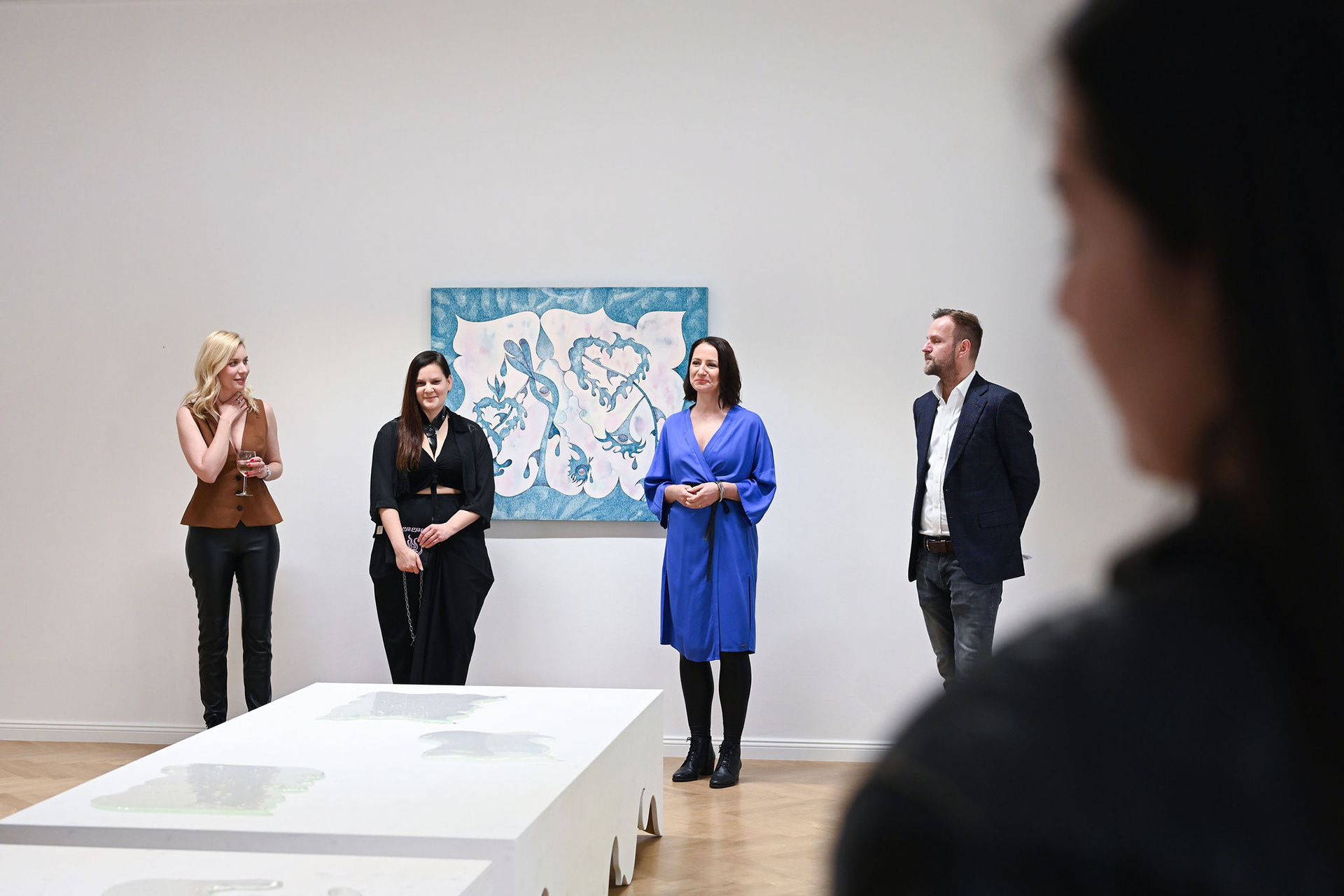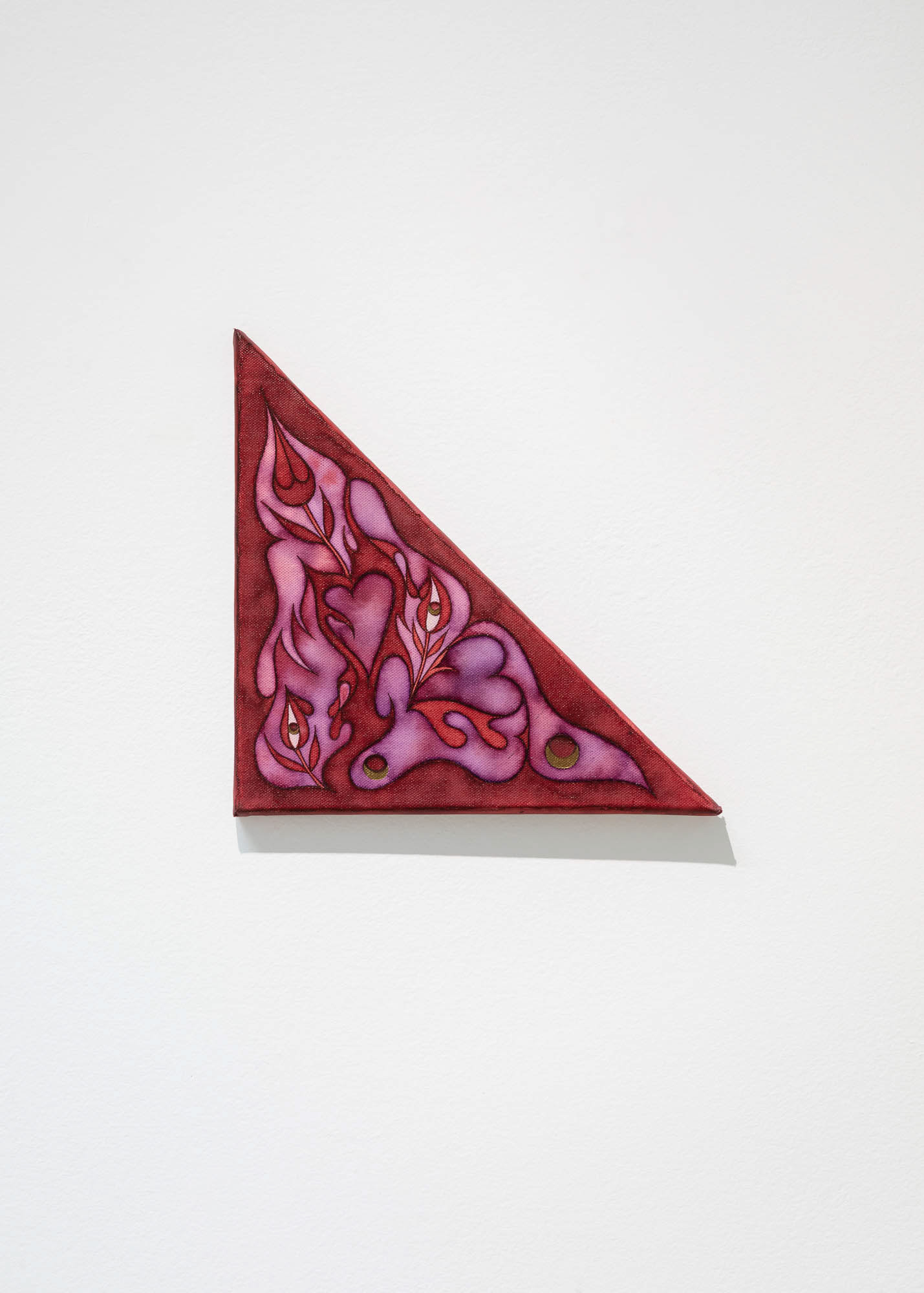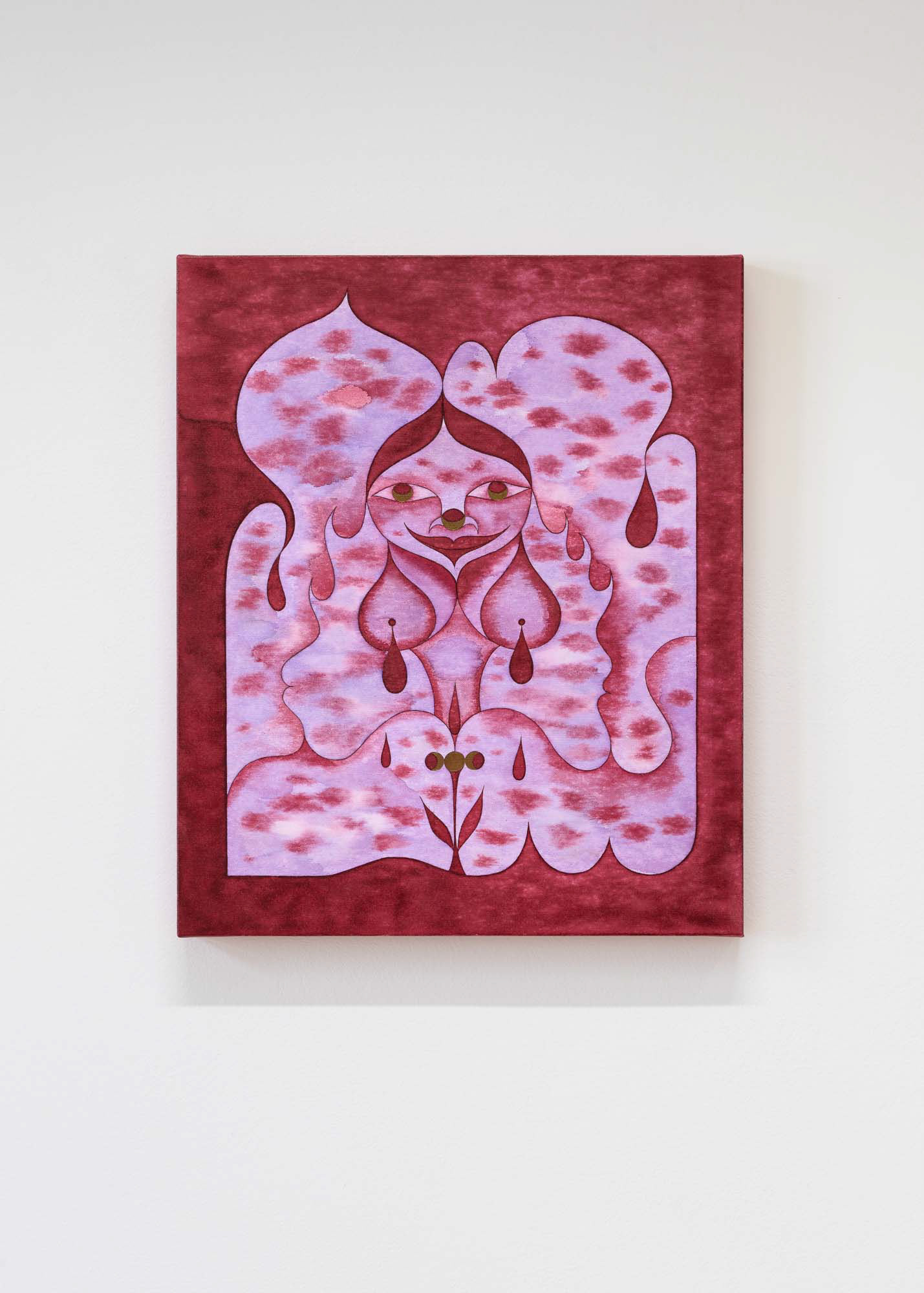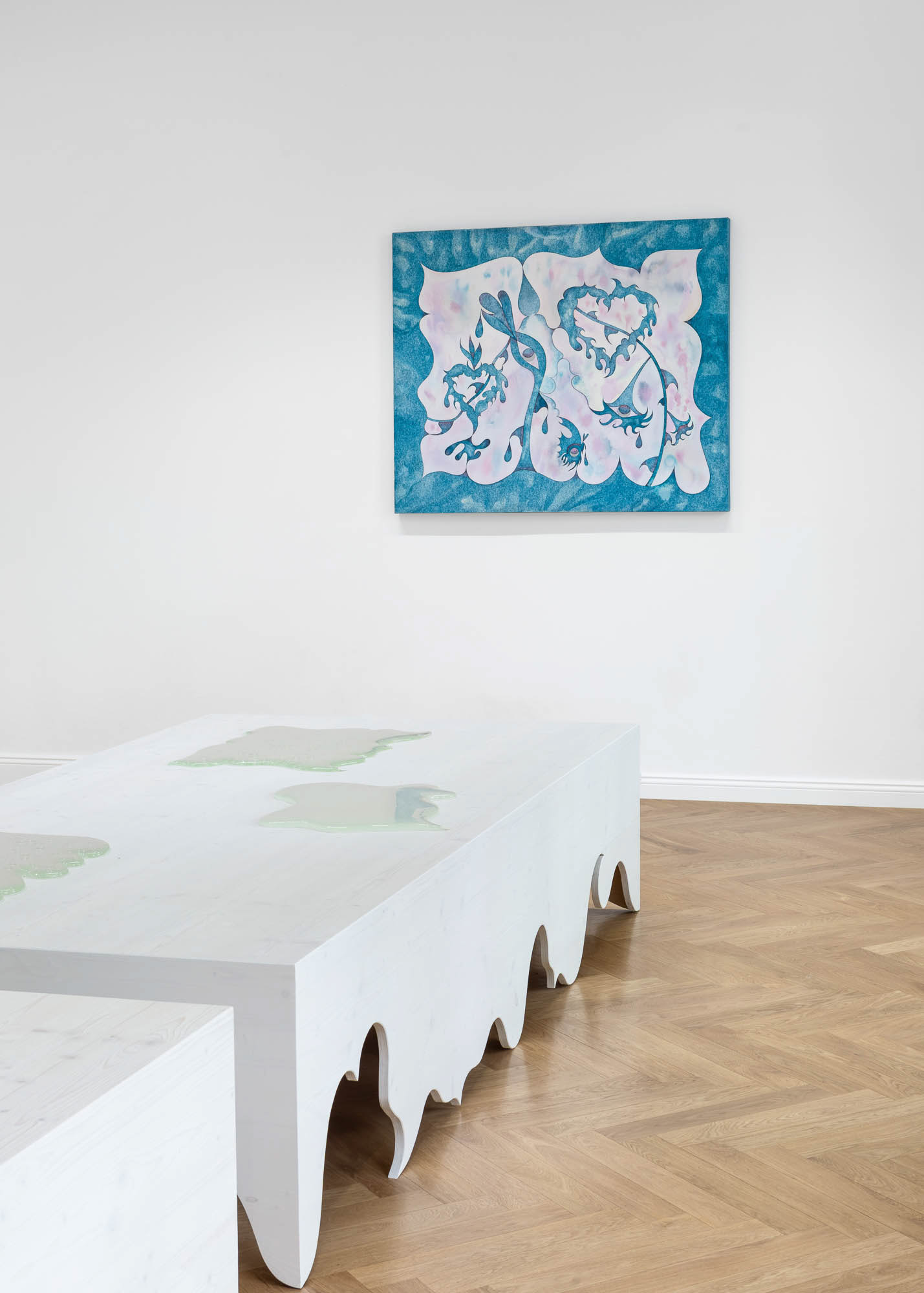Anežka Hošková
SPOT Gallery, Praha
20. 5. – 21. 6. 2025
Curated by Martina Mrázová
Photo: Anna Pleslová, MISCHA BABEL, Dávid Čerťanský














„Neboť být je především probudit se a probouzíme se ve chvíli, kdy si uvědomujeme nějaký mimořádný pocit. Jedinec není úhrnem svých obvyklých pocitů, ale úhrnem pocitů zvláštních. Tak se v nás rodí ona důvěrně známá tajemství, jež na sebe berou podobu vzácných symbolů. To v blízkosti vody a jejích květin jsem nejlépe pochopil, že snění je jakýsi emanující svět, vonný dech, jenž prostřednictvím snícího vane z věcí.“ (Gaston Bachelard, Voda a sny)
Anežka Hošková je umělkyně, která jako jedna z prvních přinesla do českého prostředí povědomí o mezinárodním proudu tzv. emo-romantické malby. V její tvorbě se spojuje silný emocionální náboj a zájem o oblast spirituality a mystiky s vlivem vizuality alternativních hudebních subkultur, k nimž má sama velmi blízko. Obrat k subjektu, k niternému prožitku i k tajemným oblastem, které přesahují naše racionální chápání, se v době mnohačetných krizí stal jednou z relevantních možností, jak v sobě můžeme probouzet větší vnímavost a citlivost ke druhým bytostem i k celému světu. V tvorbě Anežky Hoškové se tak skrze introspekci přirozeně dostáváme k aktuálním otázkám globálního světa včetně klimatické změny, feminismu či krize identity a mezilidských vztahů.
Anežka Hošková sama sebe považuje především za kreslířku, věnuje se ale také malbě a často přechází i k tvorbě objektů a performativních instalací, v nichž se sama stává součástí scénicky utvářeného díla. V posledních letech se stále více zajímá i o tradiční uměleckořemeslné techniky a vedle vitráží začala nově experimentovat i s trojrozměrnými objekty ze skla, které dále rozvíjí její osobitý výraz, vycházející primárně z kresebného projevu.
Ze všech uměleckých technik však pro Anežku Hoškovou nadále zůstává charakteristický především akvarel, jenž svou spontánností a organičností nejlépe odpovídá jejímu naturelu. Barevné pigmenty rozmývané vodou se do značné míry vzpírají kontrole a pevnému uchopení. Rozlévají se a vpíjí do sebe v útvarech a strukturách, které autorka koriguje živými tahy štětce v mezích předem určených ostrou linkou kresby. Uvolněné akvarelové malby evokují víření energií či oblaků a vytvářejí představu snové krajiny prozářené světlem, v níž zůstává zachována bezprostřednost gest a pocitů spolu s prchavou proměnlivostí okamžiku. Vodní roztok zpravidla monochromních barev s sebou nese určitý druh lyrické syntaxe, spjatý s pozvolným, organickým pohybem, díky němuž se v malbách šíří jemné vibrace, které nás vtahují dovnitř a aktivují naši imaginaci.
Svoboda vyjádření, hravost, intuice i podnětnost tvůrčích asociací se v tvorbě Anežky Hoškové propojují s představami starých kosmologií, jež ve vodním živlu spatřovaly prapůvodní substanci. K metafoře sepětí se světem na nejhlubší úrovni primordiálních sil nás přitom nevede jen samotná tekutá povaha akvarelových maleb, ale také kresebně vymezené tvary symbolů a ornamentů, s nimiž autorka pracuje dlouhodobě. Zatímco v dřívější tvorbě využívala synkretickou směs zejména mystických a magických symbolů různých proveniencí, nyní v její tvorbě převládá florální symbolika s fragmenty lidského těla. V obrazech plačících květin a planoucích srdcí Anežky Hoškové ožívá vitalistická představa živoucí přírody, která se nyní nově zhmotňuje i do podoby trojrozměrných objektů ze skla. Jednoduché plošné objekty z průzračného skla, jež někdy autorka dále pojednává barvou, přináší do její tvorby výrazné zklidnění. Čistota materiálu v ostře vymezených ornamentálních tvarech nás vrací k představě „jezer napájených kosmickými slzami, jež kanou z celé přírody“, abychom se na závěr vrátili k přiléhavé imaginaci Gastona Bachelarda.
Martina Mrázová
“For to be is primarily to awaken, and we awaken the moment we become aware of an extraordinary feeling. An individual is not the sum of his/her usual feelings, but the sum of their special feelings. Thus are born in us the familiar secrets that take on the form of precious symbols. It was in the proximity of water and its flowers that I best understood that dreaming is a kind of emanating world, a fragrant breath which, through the dreamer, wafts from things.” (Gaston Bachelard, Water and Dreams)
Anežka Hošková is an intermedia artist who was one of the first to bring awareness of the international Emo-Romantic painting movement to the Czech environment. Her work combines a strong emotional charge as well as interest in spirituality and mysticism with the influence of the visuality of alternative music subcultures, which are close to her heart. In times of multiple crises, turning to the subject, its intimate perceptions and the secret realms that transcend our rational understanding has become one of the relevant ways of awakening a deeper receptivity and sensibility to other beings as well as to the entire world. Through this introspection, Anežka Hošková’s work naturally leads us to the world’s current issues including climate change, feminism, or identity and relationship crisis.
Anežka Hošková primarily considers herself a drawer, but she also paints and often also creates objects as well as performative installations in which she becomes part of the scenic work of art. In recent years, she has become increasingly interested in traditional arts and crafts techniques and, in addition to stained glass, she has also started experimenting with three-dimensional glass objects that further develop her distinctive expression, which is primarily based on drawing.
Of all the artistic techniques, however, watercolour remains the most characteristic for Anežka Hošková, as its spontaneity and organic nature best suit her personality. The coloured pigments washed with water largely defy control or a firm grip. They spill and melt into each other to create forms and structures that the author adjusts with lively brush strokes, within the limits of the sharp drawn lines. Relaxed watercolour paintings evoke swirling energies or clouds, creating the idea of a dreamscape illuminated by light, in which the immediacy of gestures and feelings is preserved along with the fleeting mutability of the moment. The aqueous solution of usually monochromatic colours carries with it a kind of lyrical syntax, linked to a gradual, organic movement that spreads vibrations within the paintings, making them draw us in and activate our imagination.
In Anežka Hošková’s work, the freedom of expression, her playfulness, intuition and stimulating creative associations are connected with the ideas of ancient cosmologies that considered the element of water a primordial substance. It is not only the liquid nature of the watercolour paintings that leads us to the metaphor of being connected with the world at the deepest level of the primordial forces; it is also the drawing-defined shapes of the symbols and ornaments with which the author has been working for a long time. While in her earlier work, she used a syncretic mixture of mainly mystical and magical symbols of various origins, currently, floral symbolism with fragments of the human body is dominant in her work. In Anežka Hošková’s paintings of weeping flowers and flaming hearts, the vitalistic idea of the living nature comes to life, which is now newly materialized in the form of three-dimensional objects made of glass. Simple flat objects made of transparent glass, which are sometimes further treated with colour, bring a distinct calming to her work. The purity of the material in the sharply defined ornamental shapes brings us back to the idea of “lakes fed by cosmic tears that flow from all of nature”, to conclude again with Gaston Bachelard’s apt imagery.
Martina Mrázová